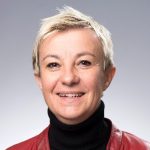September Webinar
Vascular Contribution in the Response to FLASH and SFRT
19 September at 17:00 – 18:30 CET
Our Chairs:

Marie-Catherine Vozenin
Switzerland

Anna Grebinyk
Ukraine
“The research projects that I develop with my team have a primary goal of discovering innovative tools able to protect normal tissue and enhance tumor control. One significant accomplishment has been the development of a groundbreaking radiation therapy technique called FLASH-Radiotherapy, which offers to reduce normal tissue toxicity and eradicates tumors in various organs including the brain, lung and skin. We have successfully tested this new approach of RT on various species, including mice, zebrafish, mini-pigs, and cats. Our efforts have primarily focused on exploring the distinct biological reactions triggered by FLASH exposure on normal tissue and tumors and recently we found that FLASH could overcome radiation resistance. A crucial aspect of our work involves ensuring the advancement of FLASH-RT into safe and meaningful clinical trials for human cancer patients.”
Anna Grebinyk, a biochemist of Ukrainian origin, a researcher and head of a biolaboratory at Photo Injector Test Facility in Zeuthen (PITZ) at Deutsches Elektronen-Synchrotron (DESY), is helping to build the bridge between accelerator physics and biomedical research at the FLASHlab@PITZ R&D platform that opens up the new ultra high dose rate FLASH cancer radiation therapy.
Anna graduated with high distinction from Kyiv National Taras Shevchenko University, earning a Bachelor’s degree in Biology in 2011 and a Master’s degree in Biochemistry in 2013. Following her graduation, she continued her research on synergistic cancer therapies at the Technical University of Applied Sciences (TUAS) Wildau. In 2021, Anna earned her PhD in Biology from the University of Würzburg with summa cum laude honors.
Since 2020, she has been working on cancer multimodal therapies at TUAS Wildau, where she serves as a Post-Doc and Junior Research Group Leader. In 2019, she joined a collaborative effort to advance cancer radiation therapy research at PITZ, DESY. By 2022, Anna integrated into PITZ to establish the biological infrastructure and research initiatives.
Meet Our Speakers:

Jennifer Fazzari
Postdoctoral Research Fellow
Mayo Clinic
Rochester, United States

Vincent Potiron
Radiobiologist
Institut de Cancérologie de l'Ouest
University of Nantes, France

Jeannette Jansen
Scientist in Radiation Oncology
CHUV
Lausanne, Switzerland
Presentation Title: “Vascular Effects Induced by Microbeam SFRT”
Presentation Title: “Vascular Response to FLASH Proton Therapy: Lessons from Zebrafish Embryos”
Presentation Title: “Tissue Oxygen Perfusion: A Compartmental Model Analysis to Understand Oxygen’s Potential Role in the FLASH Effect”
Dr Fazzari holds a PhD in Physiology and Pharmacology and a Postdoctoral Research Fellow in Microbeam Radiation Therapy.
Dr Vincent Potiron, PhD, is a radiobiologist at Institut de Cancérologie de l’Ouest, University of Nantes, France. His work is focused on the effects of radiotherapy on the vascular microenvironment and reoxygenation
Jeannette Jansen holds a PhD in Medical Physics which she obtained from University of Heidelberg at the German Cancer Research Center in the lab of Joao Seco. During her PhD, she focused on the role of oxygen and especially oxygen depletion in FLASH-radiation therapy. After completing her PhD in 2022, she did a PostDoc at CHUV in Lausanne, Switzerland in the lab of Marie-Catherine Vozenin working on MRI as a tool to evaluate FLASH effects, as well as the role of vasculature in the FLASH effect.
This year, she transitioned to the radiobiology lab of Marco Durante at GSI in Darmstadt, Germany, working now with heavy ions.


